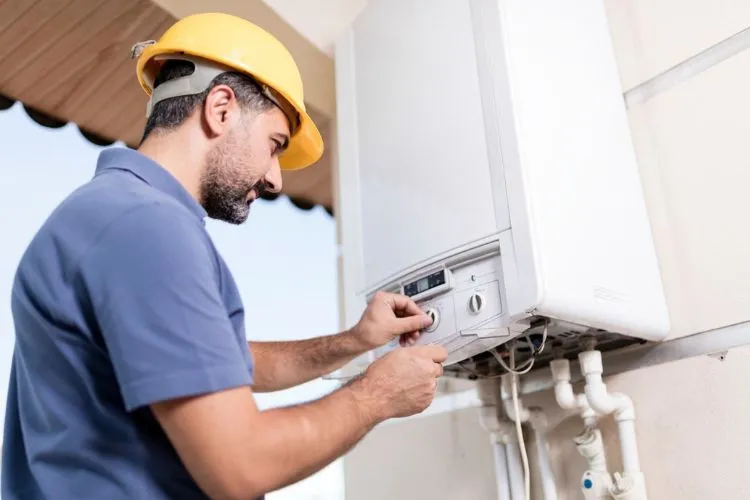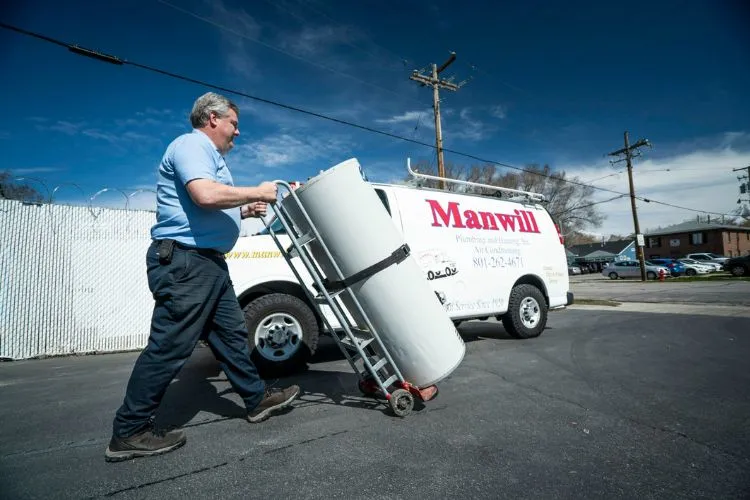When it comes to relocating or upgrading your home, the logistics of moving large appliances can often lead to a maze of questions.
But, can you lay a water heater on its side?
This is one particular query that frequently arises because it has a serious use case for transportation or storage purposes.
Navigating this question requires understanding the risks involved, the proper precautions to take, and the differences between water heater types.

Can You Lay A Water Heater On Its Side?
Laying a water heater on its side is generally not recommended due to the potential risks of structural and internal damage. This positioning can cause components to shift or become dislodged, possibly leading to operational issues or voiding the manufacturer’s warranty.
However, in situations where it is unavoidable to transport or store a water heater on its side, it is crucial to take specific precautions. These include completely draining the unit, securely fastening loose components, and providing ample padding to protect against impacts.
For gas water heaters, extra care must be taken due to the sensitivity of the gas connections and components. It’s always advisable to consult the manufacturer’s guidelines and consider seeking professional advice to ensure the safety and integrity of the water heater during such movements.
Risks of Laying a Water Heater On Its Side
Transporting a water heater on its side is not as straightforward as it may seem. The primary concern revolves around the potential for structural and internal damage. Water heaters, whether tankless or with a tank, are designed to stand upright. This orientation is critical for their structural integrity and proper functioning.

Structural Risks
The outer shell of a water heater, although sturdy, is not designed to bear weight on its sides. This misalignment can lead to dents or warping, which, while seemingly minor, can compromise the insulation and overall efficiency of the unit.
Potential for Internal Damage
Internally, the components of a water heater, including the heat exchanger, anode rod, and dip tube, are precisely placed for optimal performance. Laying the unit on its side can dislodge these components, leading to reduced efficiency or even failure. For gas water heaters, the displacement of gas lines could pose significant risks when reconnected.
Warranty Concerns
Many manufacturers stipulate in their warranty terms that improper handling, including transporting the unit on its side, can void the warranty. This means any resulting damage would not be covered, leading to potentially expensive repairs or replacements.
When It’s Considered Safe to Lay a Water Heater On Its Side
In certain scenarios, laying a water heater on its side may be inevitable. Understanding when and how it’s safe to do so can save a lot of headaches.
Gas vs. Electric Water Heaters: Is There a Difference?
Gas water heaters typically contain more sensitive components than their electric counterparts, making them more susceptible to damage when laid on their side. If you must transport a gas water heater sideways, extra caution is needed.
Precautions to Take Before Laying Your Water Heater Sideways
Preparing your water heater for safe sideways transportation involves several steps. Firstly, ensure the unit is completely drained to prevent water from causing internal damage. Secondly, detach any external components, such as pipes or valves, to avoid them getting bent or broken.
Step-by-Step Guide to Safely Transport a Water Heater On Its Side
Transporting a water heater requires meticulous planning and handling. Here’s how to do it right:

Pre-transportation Checklist
Before moving the water heater, create a checklist that includes draining the unit, securing loose parts, and carefully inspecting it for any pre-existing damage.
Securing the Heater During Transportation
Use sturdy straps to secure the water heater in place within your vehicle, ensuring it doesn’t shift or roll during transit. Padding the sides with blankets or foam can provide additional protection against bumps.
What to Do Immediately After Transport
Upon arrival, carefully inspect the unit for any signs of damage. It’s crucial to keep the water heater on its side for as short a period as possible, and to reinstall it in its upright position promptly.
Pro Tips for Handling and Installation After Transport
Handling and installation after transport are critical to the unit’s longevity and safe operation. Here are professional insights to guide you:
Inspection Tips
Thoroughly inspect the unit for any signs of physical damage, such as dents, leaks, or dislodged parts. Use a flashlight to check inside the combustion chamber of a gas water heater for any disconnections or debris.
Installation Advice from Experts
Ensure that the installation site is level and sturdy. Reconnect all parts carefully, following the manufacturer’s guidelines. For gas water heaters, it’s particularly important to check all gas connections for leaks using a leak detection solution.
Common Mistakes to Avoid
Avoid rushing the installation process. Take time to ensure all connections are secure and that the unit is perfectly vertical. Ignoring manufacturer instructions or bypassing local codes and regulations can lead to operational problems or legal issues.
Frequently Asked Questions (FAQs)
Can laying a water heater on its side void the warranty?
Yes, many manufacturers specify that improper handling, including laying the unit on its side, can void the warranty. Always consult your warranty documentation or contact the manufacturer directly for clarification.
How long can a water heater be stored on its side?
Storage duration should be as brief as possible. Extended periods on its side can cause unanticipated strain and potential damage, even if the unit is not in operation.
Can you transport a tankless water heater on its side?
Transporting a tankless water heater on its side is generally less risky than a traditional tank model, but precautions should still be taken to avoid damage to internal components.
Conclusion:
While transporting a water heater on its side is not recommended due to the risk of damage and voiding warranties, understanding the correct precautions and methods can make it safer when no other options are available.
The key is to plan carefully, follow expert advice, and inspect the unit thoroughly before and after transport. By respecting these guidelines, you can minimize the risks and ensure the longevity and efficient operation of your water heater.
Considering installing a new water heater or need expert advice on handling and maintenance? Don’t hesitate to consult with a professional plumber or installation expert.
Proper guidance can save time, money, and ensure your home’s safety and comfort. For more insightful guides and tips on water heater maintenance, explore our resources and stay informed.


